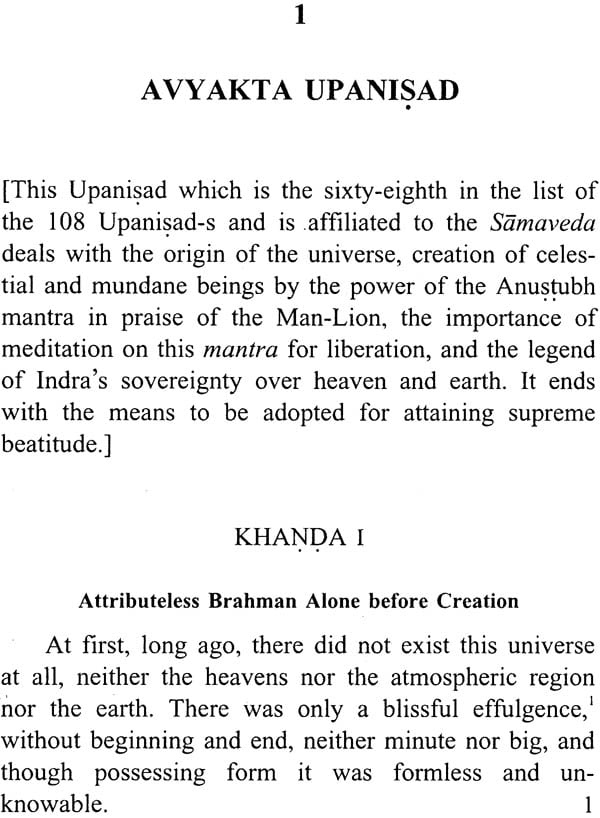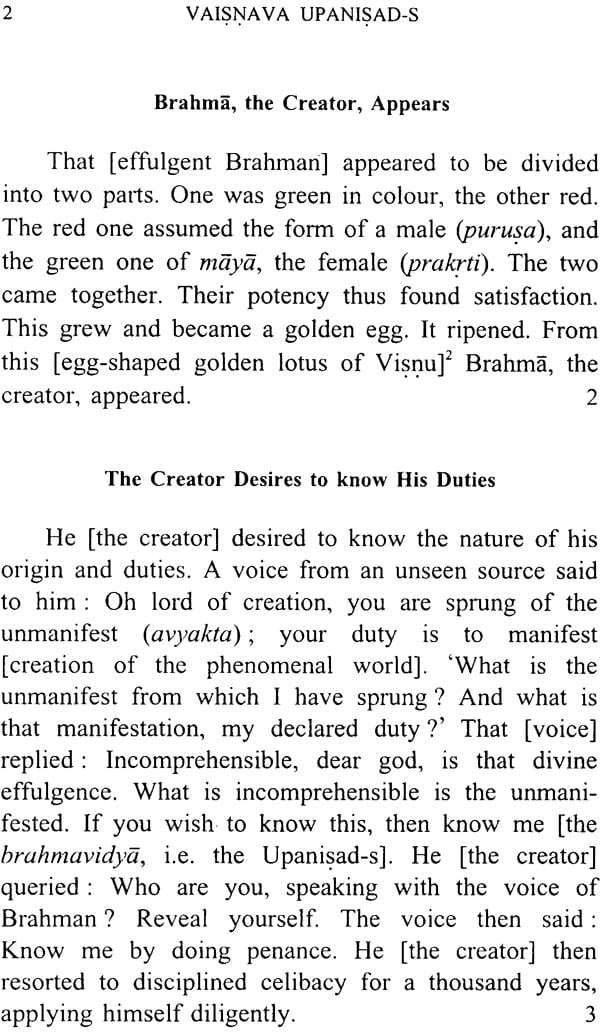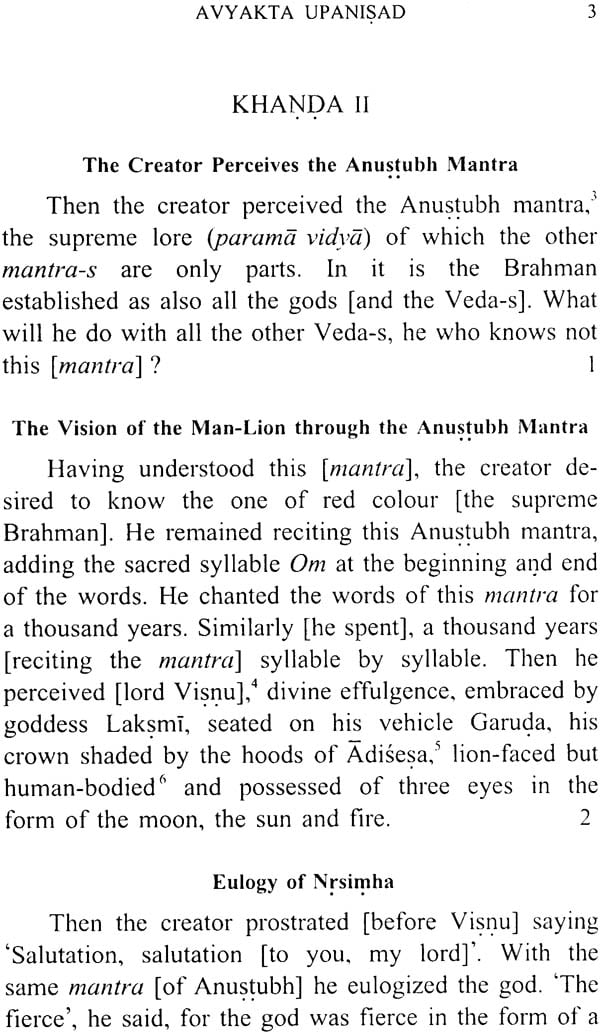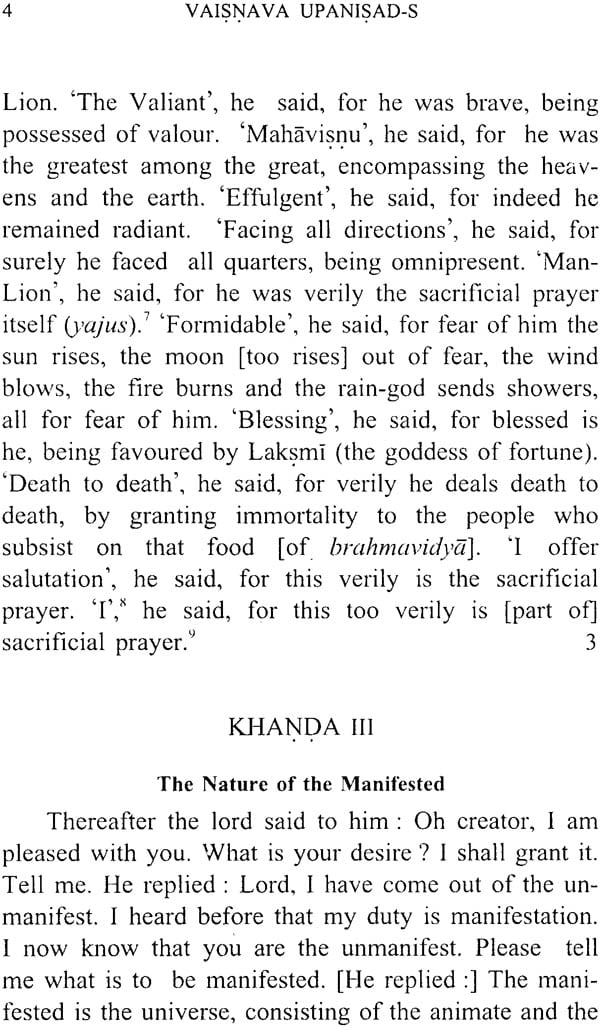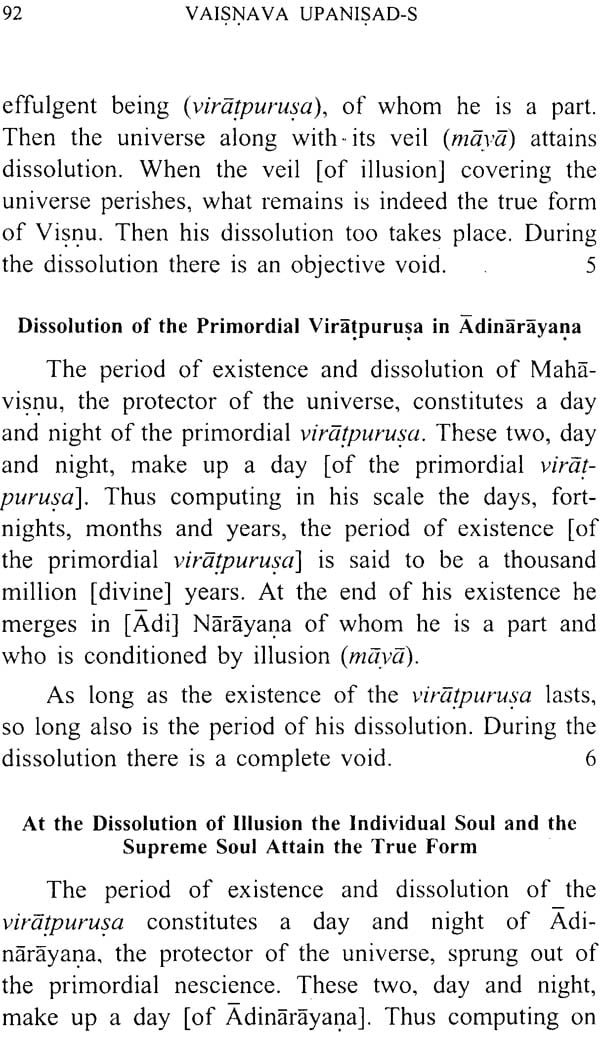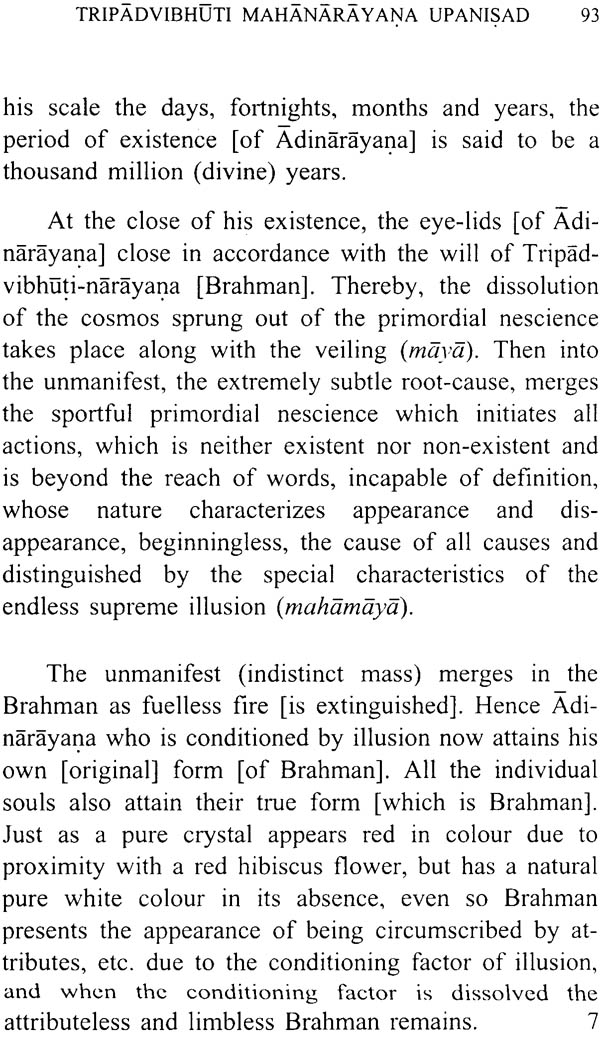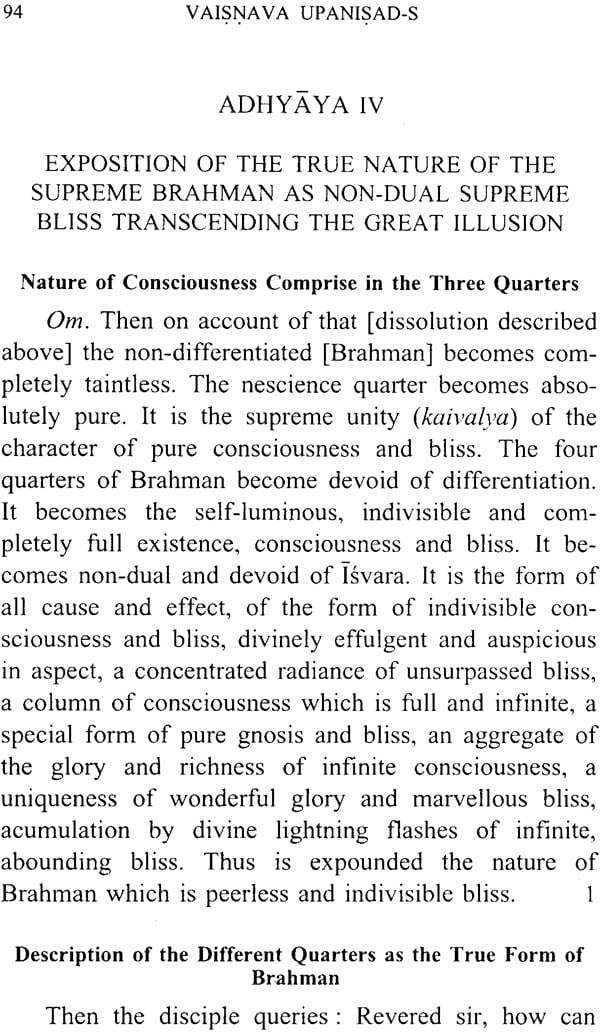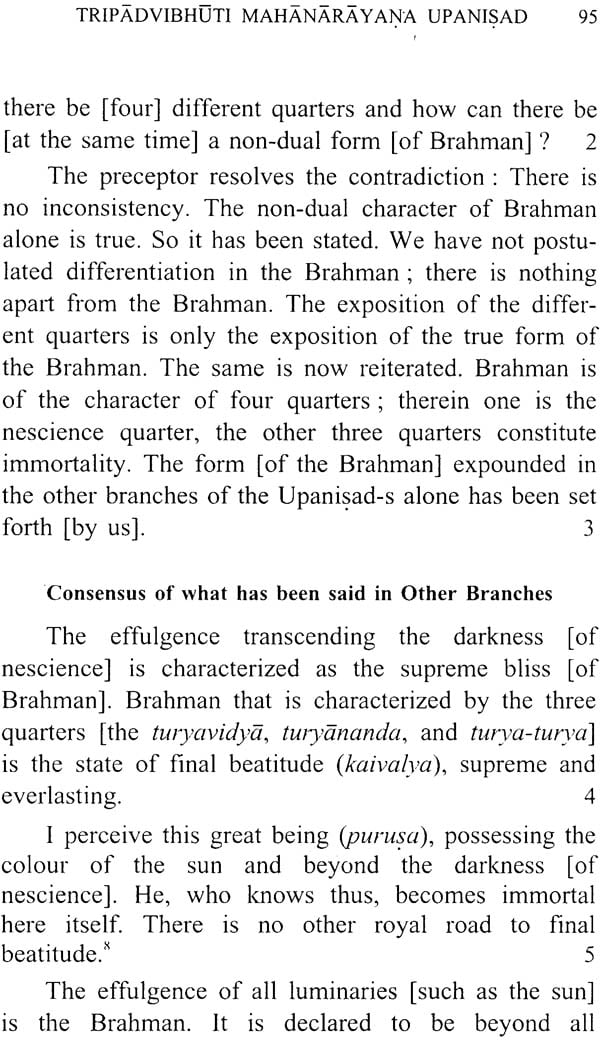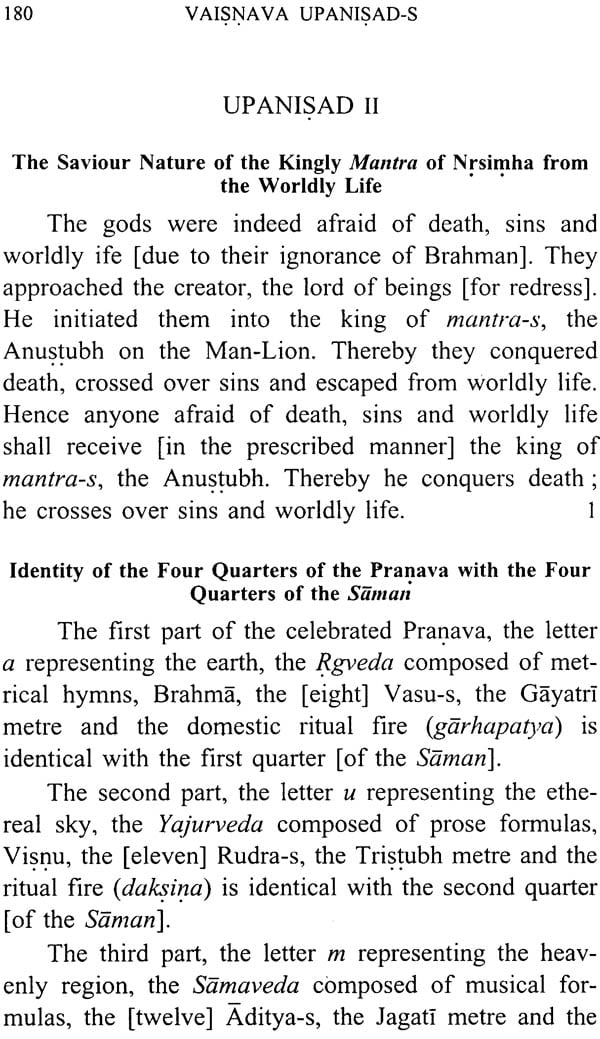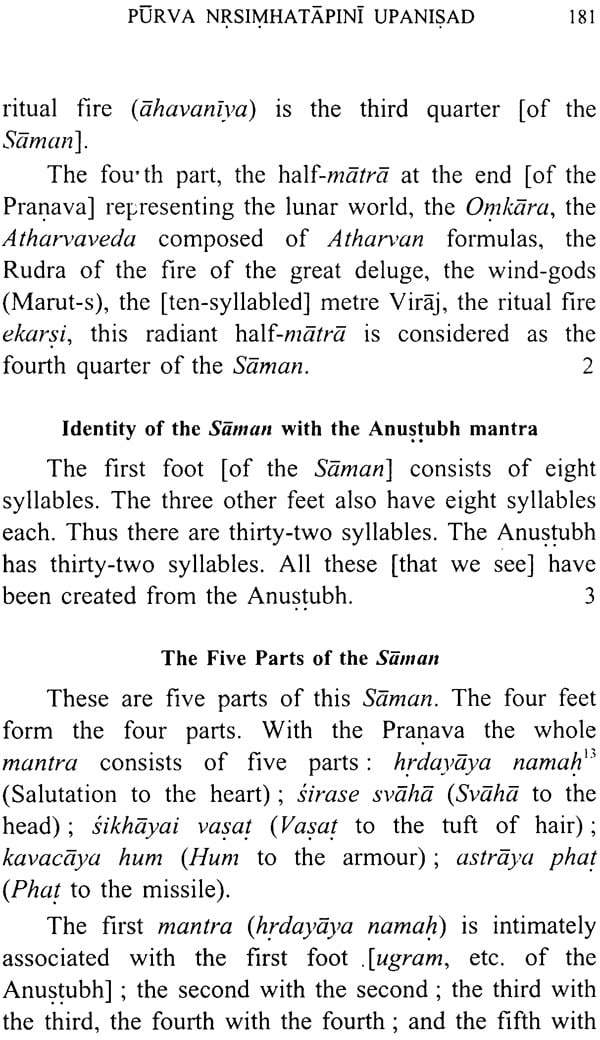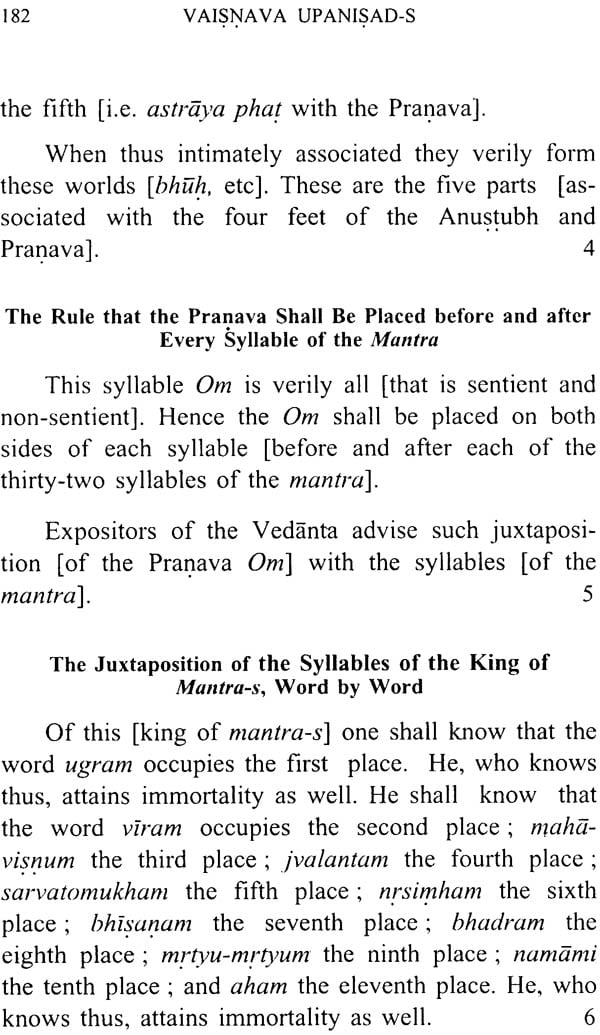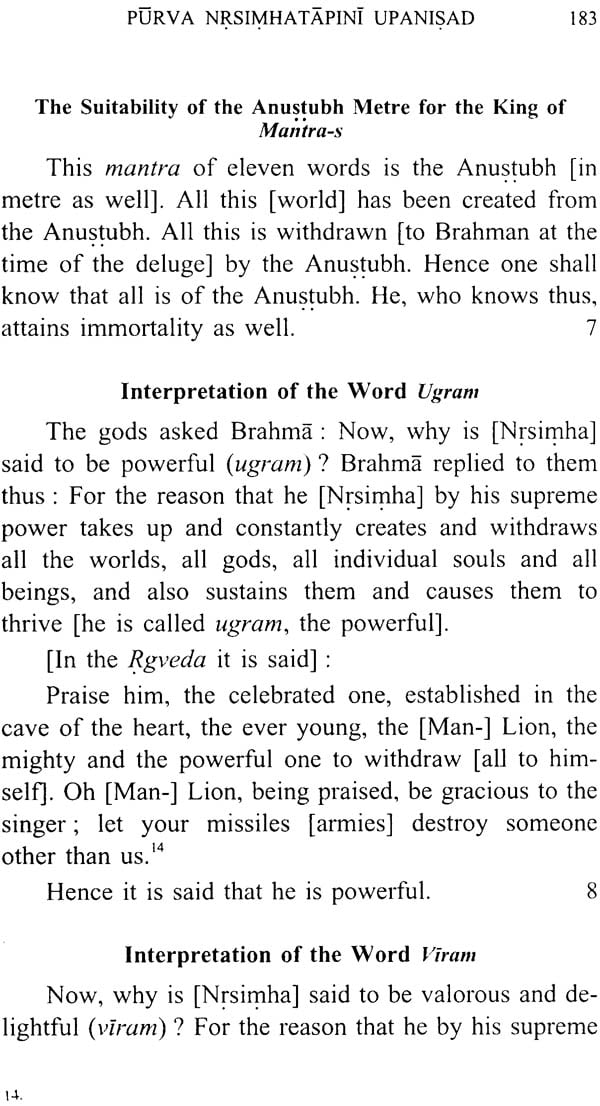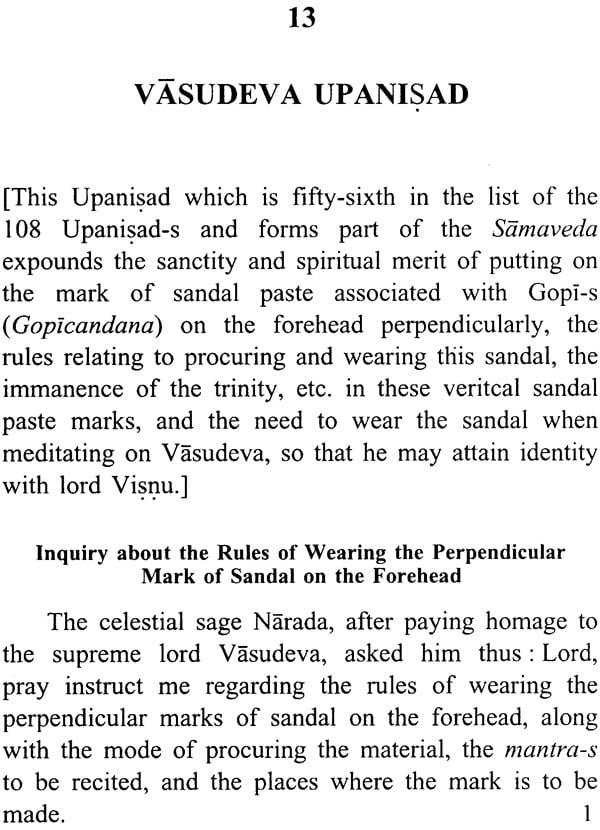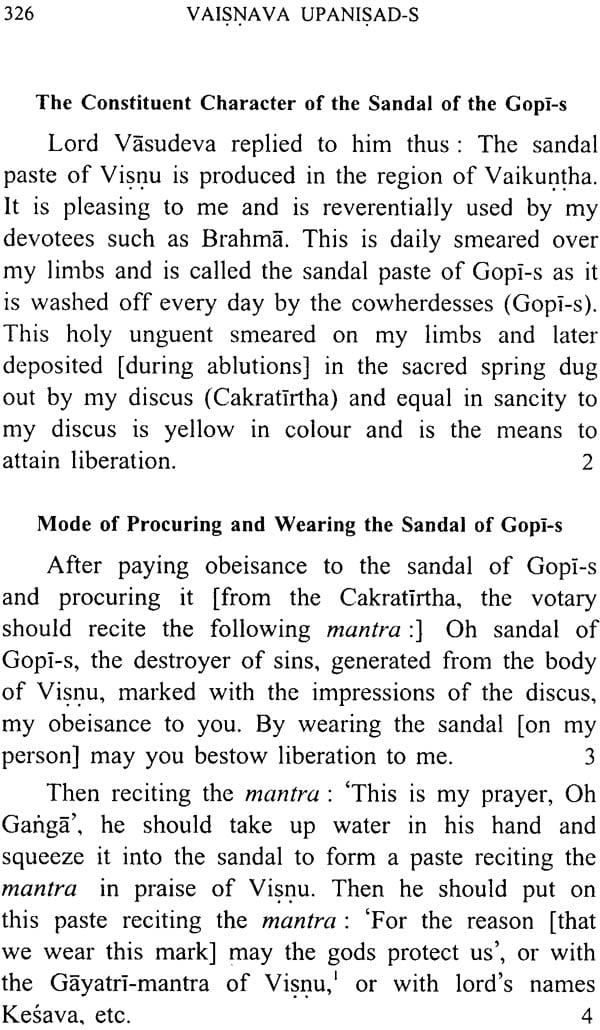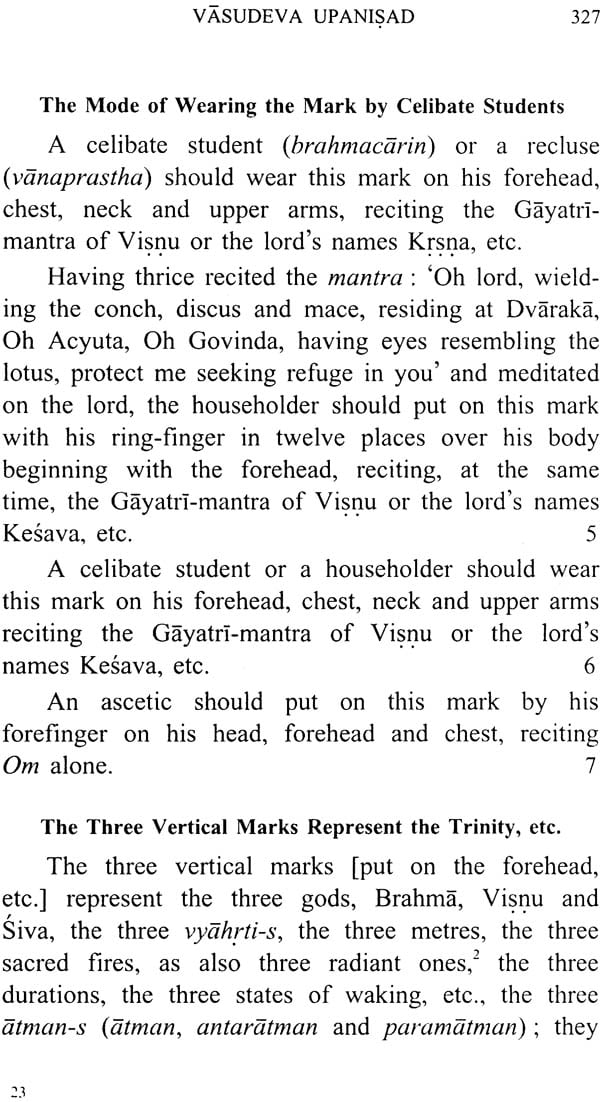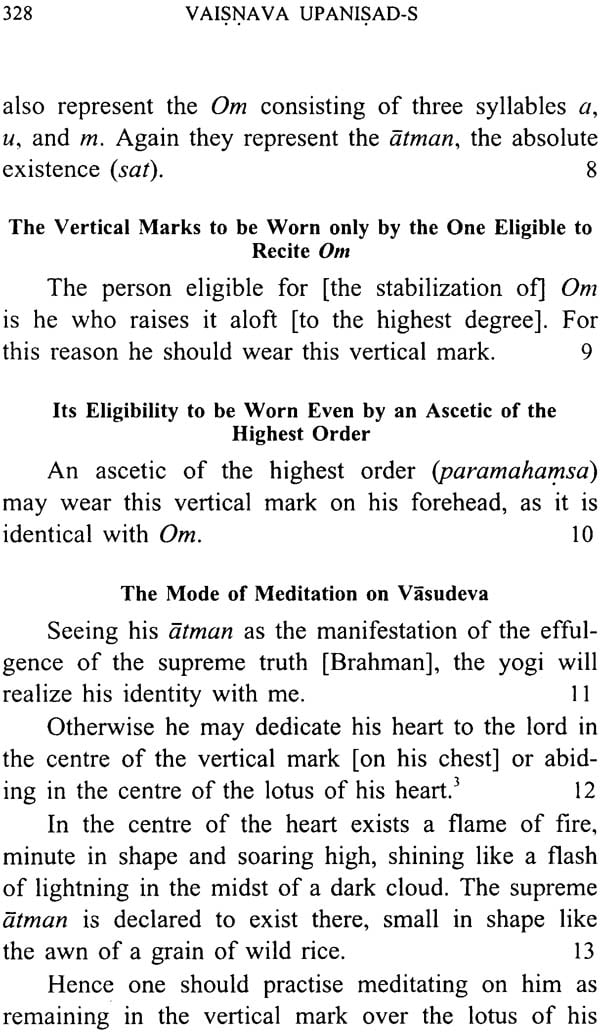
The Vaisnava Upanisad-s - English Translation Based on the Commentary of Upanisad Brahmayogin
Book Specification
| Item Code: | IHJ019 |
| Author: | A.A. Ramanathan |
| Publisher: | The Adyar Library and Research Center |
| Language: | (English Translation Only) |
| Edition: | 2002 |
| ISBN: | 8185141428 |
| Pages: | 369 |
| Cover: | Hardcover |
| Other Details | 8.7 inch X 5.7 inch |
| Weight | 690 gm |
Book Description
Fourteen Vaisnava Upanisad-s, dealing with philosophical and agamic topics, translated into English by Prof. A. A. Ramanathan on the basis of the commentary of Upanisad Brahmayogin, constitute this volume. These Upanisad-s deal with the creation of the worlds, the gods, Vasu-s, Rudra-s, Aditya-s, etc. Detailed descriptions are given of the Pranava, Gayatri and other mantra-s, and yantra-s or the modes of worship, and of the means of liberation leading to the final beatitude.
The Adyar Library and research centre was founded in 1886 by Henry Steel Olcott, first President of the Theosophical Society, for research in Eastern Civilization, Philosophy and Religion. Its aim is to promote understanding among the peoples of the world through knowledge of the higher aspects of their respective cultures.
The collections of the Library consist of about 18,000 manuscripts, containing about 45,000 printed volumes. The manuscripts are mostly from Indian and in Sanskrit. The printed books include old and rare Indological works and also a fine collection of books on the different religions and philosophies, in Sanskrit, English, and various other languages, eastern and western; and volumes of important Indological journals.
Brahmavidya, The Adyar Library Bulletin is being published annually since 1937, presenting papers and studies on religion, philosophy and various aspects of Sanskrit and other oriental literature as well as editions of ancient texts and translations.
The fourteen Upanisad-s published by us as The Vaisnava Upanisad-s are found in the list of 108 Upanisad-s in the Muktikopanisad. The Vaisnava Upanisad-s generally belong to the Tantra school advocating worship of the various aspects of Visnu as Narasimha, Rama, Krsna using mantra-s, and tantra (gestural worship). The Nrshimha Tapiniya Upanisad is quite popular, and there is a commentary on it ascribed to Sri Samkaracarya. This is definitely later than Sri Samkaracarya. However, it is earlier than Narayana-bhatta of Kerala who refers to it in his Narayaniya (A.D. 1558).
The Adyar Library has published all the 108 Upanisad-s with the commentary of Upanisad Brahmayogin. It has also the commentaries on the 108 Upanisad-s by another scholar Appayya Diksita, an eighteenth century Brahmin of Tirunelveli district in Tamilnadu. He passed away at Naranammalpuram in 1901. His commentary was based on the Anubhavadvaita system of thought which seems to be akin to the light within mentioned by the Buddha, and by the masters mentioned by Madame Blavatsky.
The late Professor A.A. Ramanathan has translated the Upanisad-s in a lucid form according to our new pattern of traslation. We hope than it will be appreciated by the seekers of truth.
| Preface | V | |
| 1. | Avyakta Upanisad | |
| Khanda I | Attributeless Brahman alone before creation; Brahma, the creator, Appears; The creator desires to know his Duties | 1-2 |
| Khanda II | The creator perceives the anustubh mantra; The vision of the man-lion through theanustubh mantra; Eulogy of Nrsimha | 3-4 |
| Khanda III | The nature of the manifested; Meditation the means to create the world; Superiority of worship by meditation | 4-5 |
| Khanda IV | The creator obtains omniscience by meditation; Others too may get omniscience by meditation | 6 |
| Khanda V | Creation of the three worlds; Creation of Vasu-s, Rudra-s and Aditya-s; Creation of the four classes (Varna-s); Creation of day and night; Creation of Veda-s and Vedic metres | 6-8 |
| Khanda VI | Creation of the pair, male and female; Legend of Indra; Means of establish one’s self in the supreme self | 8-10 |
| Khanda VII | Fruit of studying this lore; Rule for imparting this spiritual lore | 11-12 |
| 2. | Kalisamtarana Upanisad | |
| Overcoming the evils of the iron age by the mere remembrance of the names of the lord; Sixteen names which destroy the veil of supreme Brahman; The great efficacy of reciting the Lord’s names | 13-15 | |
| 3. | Krsna Upanisad | |
| Khanda I | Sri Rma’s promise to incarnate himself as Krsna; Description of the Lord as immanent in all | 17-21 |
| Khanda II | 22-23 | |
| 4. | Garuda Upanisad | |
| Traditional transmission of the Garuda-mantra; The seer etc. of the Garuda-mantra; Prayer for meditation; Malamantra, etc. of Garuda; The fruit of studying this Upanisad | 25-34 | |
| 5. | Purva Gopalatapini Upanisad | |
| Upanisad I | Benedictory verse; Supreme Godhood of Gopalakrsna; Ascertainment of the True nature of Gopalakrsna; Medition on the specific form of Gopalakrsna; Soft recitation of the Mantra on Gopalakrsna; Worship of Gopalakrsna | 35-39 |
| Upanisad II | Mode of worshipping Govinda | 39-41 |
| Upanisad III | The eighteen-syllabled mantra: the means employed for creation | 41-42 |
| Upanisad IV | This [Mantra] itself is the means of self-realization | 42 |
| Upanisad V | Creation of the universe from the five words of the mantra; Praise of Govinda who Embodies the five words | 43-45 |
| Upanisad VI | Mode of meditation, Reciting prayers and worship of Gopalakrsna | 45-46 |
| Uttara Gopalatapini Upanisad | ||
| The Worthiness of Durvasas to receive Alms from the cowherdesses; Their crossing of the Yamuna by remembering Krsna’s Unfaltering celibacy; Gopi-s recross the Yamuna by Remembering the fasting of Durvasas; Gandharvi’s doubt regarding Krsna and Durvasas; Non-enjoyment of wordly pleasures by a knower of Brahman; The non-enjoyment of fruits by Krsna; Gandhri’s Queries regarding birth etc. of Gopalakrsna; Brahma’s query to Narayana regarding his incarnations; The city of Gopala named Mathura is the central one among the seven cities of the world; Gods and other celestials reside in the woods of Mathura’ Krsna’s images in Mathura Adored by Rudra and others; Seekers after liberation shall remember their oneness with Gopala; The greatness of the temple of Gopalakrsna in Mathura; Establishing the fourfold character of the one lord; Description in the form of the lord for meditation in the heart; Images to be worshipped by Gods and others; Traditional transmission of this lore | 47-63 | |
| 6 | Tarasara Upanisad | |
| Khanda I | Instruction on worship of Avimukta; The taraka-mantra on Narayana of eight subtle syllables | 65-67 |
| Khanda II | The Tarakamantra on Narayana consisting of eight subtle syllables; Deities presiding over the parts of Om; The all-soul character of Sri Rama | 67-68 |
| Khanda III | The eight Mantra-s to reveal Jambavat and others; The fruit of studying this lore and knowing the import of the Mantra-s; The supreme state attainable by a knower of this lore | 69-71 |
| 7. | Tripadvibhuti Mahanarayana Upanisad | |
| Adhyaya I | Brahmas desire to know the profound secret; Dialogue between the preceptor and the disciple revealing esoteric knowledge; Query by the disciple; The preceptor expounds the true nature of Brahman; Brahman comprising four quarters; Division into four quarters; Differentiation of the Vidya, Ananda and Turiya quarters; The fruit of knowing this truth | 74-80 |
| Adhyaya II | Doubt of the eternality of Narayana possessed of aspects; Differentiation of the one possessing aspects with and without attributes; Exposition of the one with aspects possessing attributes; Exposition of the one with aspects devoid of attributes; Exposition of the Eternality of the one with aspects of the liberated; Differentiation of the Knowledge, Bliss and Turiya parts possessed of aspect; Resolving the conflict in the division of the supreme Brahman with and without aspects; The rise of nescience from adinarayana; Greatness of Narayana Remaining in the Egg of nescience; Fruit of Knowing this lore | 81-89 |
| Adhyaya III | The world of nescience is he sport of the great illusion; Brahma merges in Mahavisnu, the Protector of the cosmos; Dissolution of Mahavisnu in the primordial Viratpursa; Dissolution; At the dissolution of Illusion the individual soul and the supreme soul attain the true form | 89-93 |
| Adhyaya IV | Nature of consciousness comprise in the three quarters; Description of the different quarters as the true form of Brahman; Consensus of what has been said in other Branches; The nature of the opening an closing of the eyelids of Adinarayana; Nature of the great illusion and the means to overcome it; Conditioning of the individual soul by its activities | 94-98 |
| Adhyaya V | Recurrence of nescience destroyed in dissolution; Investigation into the means of liberation from worldly life; Exposition of the nature of worldly life and its causes; Purification of the Inner and the outer senses by the association with Good people; Acquisition of knowledge of the truth through the grace of a good preceptor; Manifestation of the supreme Brahman in the heart through listening to the glories of the Lord and meditating on him; Ripening of knowledge through devotion and dispassion; The state of the Liberated while alive; Attaining supreme bliss by soaring higher and higher after relinquishment of the body | 99-107 |
| Adhyaya VI | Knowledge of the true nature of the universe; Knowledge of the nature of innumerable macrocosms; Attaining the state of the grat effulgent being; The true form of the great effulgent being and the fruit of knowing him; Witnessing the sports of the great Yogic illusion; Worship of Narayana in the vaikuntha of the nescience quarter; Vision of the Vaikuntha of true knowledge through the favour of Visvaksena; Reaching the palace of conscious bliss through the Vaikuntha of Brahmavidya; Reading the Vaikuntha of Tulsi; Reaching the Vaikuntha of pure consciousness and bliss; The crowning of all forms of liberation in the palace of indivisible consciousness | 107-119 |
| Adhyaya VII | Attainment of the splendour of the bliss of Brahman after mounting the eternal Garuda; Description of the city of Sudarsana-vaikuntha; Description of the great discus Sudarsana; Worship of the presiding deity of Sudarsana seated inside the discus; Attainment by degrees of the state of non-dual Brahman; The lofty palace of Pranava situated in the middle of the bliss-aspect; The great mystical diagram of Brahman inscribed on the seat of ananta; The form of the Yantra consisting of parts; Power of the great mystic Diagram; The true form of Adinarayana established in the great mystic diagram | 119-148 |
| Adhyaya VIII | Exposition of the differentiation of the Vaikuntha and the like of the Non-dual Brahman; Compatibility of the existence of countless Vaikuntha-s; By the knowledge of the highest truth, Brahman alone remains; Difference between yoga with and without support; Characteristics of the person competent to practice Yoga without support; The cult of devotion can be practised by all; Attainment of the state of Narayana without hardship through the Yoga of devotion; Greatness that accrues from the remembrance of the highest secret; Rule for the exclusive meditation on Adinarayana; Attainment of all welfare through devotion to Mahavisnu; The great good that comes of studying, etc. of this Upanisad | 149-157 |
| 8. | Dattatreya Upanisad | |
| Khanda I | Meditation on Dattatreya; The Monosyllabic, Taraka-mantra of Dattatreya; The Six-syllabled, Mantra of Dattatreya; The Eight-syllabled, Mantra of Dattatreya; The twelve-syllabled, Mantra of Dattatreya; The Sixteen-syllabled, Mantra of Dattatreya; The anustubh mantra of Dattatreya | 159-163 |
| Khanda II | The malamantra of Dattatreya | 163-165 |
| Khanda III | Fruit of knowing the mystic lore of Dattareya | 165-166 |
| 9. | Narayana Upanisad | |
| Khanda I | The origin of all, animate and inanimate, from Narayana | 167-168 |
| Khanda II | The all-embracing character of Narayana | 168 |
| Khanda III | The eight-syllabled Mantra of Narayana | 168-169 |
| Khanda IV | The Pranava-mantra of Narayana; The fruit of studying this lore | 169-170 |
| 10 | Purva Nrsimhatapini Upanisad | |
| Upanisad I | The mantra for peace; The creation of the world due to the desire of Brahma; Anustubh mantra the source of the entire universe; The four feet of the king of Mantra-s; Query regarding the seer, metre, presiding deity, etc.; Fruit of practicing this mystic mantra with its feet and divisions; Ineligibility of women and Sudra-s from the lore of the saman and its parts; Meditation on the saman as the form of the world, the veda-s, Brahma etc; Elevation of the saman of seven musical notes; Citation of the saman of the milky ocean; Fruit of knowing the second quarter of each foot of the mantra; Fruits of knowing the man-lion as described by the Yajurveda; Fruit of knowing the third part of the saman; greatness of the saman the king of mantra-s; The last two syllables of the four quarters and the fruit of that knowledge; Greatness of this lore | 172-179 |
| Upanisad II | The saviour nature of the kingly Mantra of Nrsimha from the worldly life; Identity of the four quarters of the Pranava with the four quarters of the saman; Identity of the Saman with the anustubh mantra; The five parts of the saman; The rule that the Pranava shall be placed before and after every syllable of the king of Mantra-s word by word; The suitability of the Anustubh metre for the king of Mantra-s Interpretation of the first word Ugram; Interpretation of the word Viram; Interpretation of the word Visnu; Interpretation of the word Jvalantam; Interpretation of the word Bhisanam; Interpretation of the word Bhadram; Interpretation of the word Bhadram; Interpretation of the word Mrtyumrtyum; Interpretation of the word Namami; Interpretation of the word Aham | 180-188 |
| Upanisad III | Seeking the knowledge of the power and seed of the king of Mantra’s; Exposition of the nature of the power; Exposition of the nature of the seed | 188-190 |
| Upanisad IV | The imparting of the Angamantra-s; Pranava of the form of Brahman; Exposition of the first quarter of the pranava; Exposition of the second quarter of the pranava; Exposition of the third quarter of the Pranava; Exposition of the fourth quarter of the Pranava; The Nature of the Savitri-Gayatri-mantra; The nature of the Yajur-Laksmi-mantra; The nature of the Gayatri-mantra of the Man-lion; The nature of the Mantra-s Part by part | 190-199 |
| Upanisad V | The desire of Gods to know the great, Discus; The Vision of the six-spoked, Discus; The Vision of the eight-spoked, Discus; The Vision of the twelve-spoked, Discus; The Vision of the sixteen-spoked, Discus; The Vision of the thirty-two-spoked, Discus; The Vision of the component parts; The vision of the great discus; The great benefit of knowing the great discus; The fruit of practicing the king of Mantra; The supreme position of the Reciter of the king of Mantra’s; Brahman alone is the final sanctuary of the reciter of the king of mantra-s | 199-206 |
| Uttara Nrsimhatapini Upanisad | ||
| Khanda I | The desire of Gods to know the Unconditioned Brahman; Instruction on the identity of the Atman and the Brahman; Instruction on the means for realizing the oneness of the Atman and the Brahman; The character of the four quarters of the Brahman; The fourfold character of Visva; The fourfold character of Taijasa; The fourfold Character of Prajna; The mere Illusory nature of the three states; the fourfold character of the Turiya; Instruction on Turiya-turya | 207-210 |
| Khanda II | The Turya-turya realized by one with the highest qualification; Turya-turya is different from those comprehended by the senses; Turya-turya does not change, Being the all-witness; procedure for identifying Om and the Atman by one with middle qualifications; Non-difference between the letter A of Om and first quarter of the Atman; Non-difference between the letter U and the second quarter of the Atman; Non difference between the letter M and the third quarter of the Atman; Elucidation of the fourth quarter; Elucidation of the Turya-turya; Instruction regarding the Turya-turya; Realization of the Turiya state by ordinary aspirants through of the king of Mantra-s | 210-215 |
| Khanda III | Meditation on the four quarters of the Pranava and the King of Mantra-s as the Turiyatman; Meditation on the first quarter; Meditation on the second quarter; Meditation on the Third quarter; Meditation on the fourth quarter; The dissolution of all in Turya-turya; Realization of the Turya-turya; The form of Brahman Consisting of Parts; Meditation on the Brahman; Realization of the Turya-turya by Meditation on Brahman consisting of Parts | 215-220 |
| Khanda IV | Consideration of the Turya-turya as the atman; Rule for the denial of the import of thesounds of Om; Meditation of the Unconditioned Brahman; The king of Mantra-s: the means of identifying Brahman and Atman; Illustrative Mantra’s with the same import | 220-223 |
| Khanda V | Identity of A of Om and the anustubh mantra; identity of U and the anustubh mantra; Identity of M and the anustubh mantra | 223-227 |
| Khanda VI | Conquest of the demons by the Gods with the power of the anustubh mantra; Attainment of self-realization by the redeemable through the anustubh mantra; Attainment of Non-dual state through Om; Renunciation; the means to realize brahman | 227-230 |
| Khanda VII | Enquiry of the Gods for the realization of Turya-turya; Advice to establish identity of Atman with Turya-turya; Fruit of establishing such identity; Self-luminous character of one’s Atman; Inconsistency of the Brahman as other than the Atman; Realization to true existence; Exposition of the true nature of the Brahman; Procedure to realize the identity of the Brahman and the Atman | 230-235 |
| Khanda VIII | The Otr character of the fourth Matra of Om; The Anujnatra Character of the fourth Matra of Om; The anujnaikarasa character of the fourth matra of Om; The Avikalpa character of the fourth matra of Om | 235-239 |
| Khanda IX | Desire to realize the Non-dual Atman; The nature of the Non-dual Atman; Illusion is Unseparated from Brahman; The Nature of Illusion; The work of Maya; This threefold character of the Atman; Difference between the individual soul and the universal soul; Entry of the Atman in the created world; Brahman the true existence; All are the Atman alone; Fulfilment of all desires by the realization of the Atman; Gods’ Perception of their own Atman; Realisation of the transcendent nature of the atman; Exposition of the impossibility of dualism; Realization as the form of consciousness of Gods; Instructing the Gods the true nature of the Atman; Instruction on the identity of the Brahman and the Atman; Denial of the special concomitants of Nesceince; Ascertaining the realization of the Non-dual Atman by the Gods; A mantra to substantiate the aforesaid idea | 239-248 |
| 11. | Rurva Ramatapini Upanisad | |
| Upanisad I | Exposition of the significance of the name Rama; Attributing form to the formless Atman for the aspirants; Chanting the mantra and worship of the Yantra for the grace of Rama | 250-252 |
| Upanisad II | The all-sufficient character of the seed-syllable of Rama | 252-253 |
| Upanisad III | Worship of Sita and Rama with the Mantra and the Yantra | 253 |
| Upanisad IV | Significance of the six-syllabled mantra of Rama; Hymn of the Gods in Honour of, Rama; Hymn of the Sages in Honour of, Rama; The splendour of Rama, the crowned, king; Mode of drawing the Yantra; The composition of Malamantra; Praise of the Yantra | 253-263 |
| Upanisad V | Worship beginning with the purification of the place and ending with the adoration of the altar; Worship of the surrounding deities preceded by meditation on the lord; Attaining liberation through the grace of the lord | 264-266 |
| Uttara Ramatapini Upanisad | ||
| Khanda I | Worship of the Avimukta | 267-268 |
| Khanda II | The six-syllabled mantra of Rama is the saviour; Fruit of reciting the Taraka; The meaning of Pranava is identical with Rama; The real nature of the Pranava and Its import; Establishing the identity of the individual Atman with the Brahman; Liberation by the true knowledge or Rama | 268-272 |
| Khanda III | The identity of the external and internal avimukta; The imparting of the saviour mantra of Rama to persons at the point of death by Siva | 272-274 |
| Khanda IV | Mantra-s for the visible presence of Sri Rama | 274-183 |
| Khanda V | Great potency of the six-syllabed mantra of Rama; Verses revealing the greatness of the king of Mantra-s | 283-288 |
| 12 | Ramarahasya Upanisad | |
| Adhyaya I | Rama as the saviour Brahman; Hanumat and other dependent deities of Rama; Eligibility of householders for reciting the Pranava as the Anga of Rama; Expiation of all the sins by reciting the name of Rama; Expiation of all sins through the Ramopanisad | 289-292 |
| Adhyaya II | The monosyllable Mantra of Rama; Mantra-s consisting of Two, Three and Four syallables; The five-syllabled Mantra; The six-syllabled mantra; Mantra-s of seven, Eight and Nine Syllables; Mantras of the ten and eleven Syllables; The Twelve-syllabled Mantra; Mantra-s of Thirteen, fourteen, and fifteen syllables; Mantra-s of sixteen and seventeen syllables; Mantra-s of eighteen and nineteen syllables; Mantra-s The twenty-syllables; Mantra; Mantra of twenty-one syllables; Mantra of Twenty-two syllables; Mantra of Twenty-three syllables; Mantra of Twenty-four syllables; Mantra-s of Twenty-five, Twenty-six syllables; Mantra-s of twenty-eight, Twenty-nine, thirty and thirty-one syllables; The anustubh mantra of Rama; Gayatri-mantra of Rama; The mantra of Sita; The mantra of Laksmana; The Mantra of Bharata; The mantra of satrughna; The mantra of Hanumat | 293-312 |
| Adhyaya III | Inquiry about the altar of worship; The Yantra for worship with Mantra-s beginning with the monosyllabic and ending with the nine-syllabled one; Chanting of the Mantra preceded by the worship of the Avarana Deities; The Yantra for the worship of the Mantra-s beginning with the ten-syllabled and ending with thirty-two syllabled one; Chanting of the mantra preceded by the worship of the Yantra | 313-317 |
| Adhyaya IV | Duties to be performed prior to the mantra of Rama; Prohibition of the practice of the mantra of Rama to gain worldly ends; For worldly ends rule relating to the remembrance of Hanumat | 318-320 |
| Adhyaya V | The six-syllabled king of Mantra-s; The significance of the seed-syllable of Rama; The significance of the Two-syllabled mantra; The significance of the Six-syllabled mantra; The exalted position of the mantra of Rama; The benefits of studying this lore | 320-323 |
| 13 | Vasudeva Upanisad | |
| Inquiry about the rules of wearing the perpendicular mark of sandal on the forehead; The constituent character of the sandal of the Gopi-s; Mode of Procuring and wearing the mark by celibate students; The three vertical marks represent the trinity, etc; The vertical marks to be worn only by one eligible to recite Om; Its eligibility to be worn even by an ascetic of the highest order; The mode of meditation on Vasudeva; Vasudeva is identical with the Atman of all; Wearing sandal gopi-s in places where Vasudeva is to be meditated; Rule for wearing the sandal of the Gopi-s and holy Ashes; The fruit of this Lore; The Fruit of a mere study of this Upanisad | 325-331 | |
| 14 | Hayagriva Upanisad | |
| The potency of the mantra of Hayagriva; The three mantra-s of Hayagriva; Three Mantra-s beginning with their seers and ending with meditation; The fourth mantra of Hayagriva; The Fifth mantra of Hayagriva; The monosyllabic mantra of Hayagriva; Proficiency in speech, etc. By the practice of the mantra; The mantra of seventeen syllables; The fruit of knowing these mantra-s; The mantra-s of Hayagriva expound the import of the great scriptural texts; Twofold nature of mantra-s owing to the difference between the vowels and consonants; Supplemental mantra-s ; Fruit of practicing this lore; Prayer to the Brahmavidya | 333-339 | |
| Notes | 341-369 |
